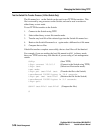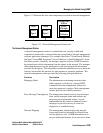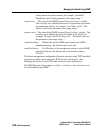
3-52 Switch Management
GigWorks MkII-16 Switch Model MKII-BASE16
59003-01 Rev. A Installer's/User's Manual
Managing the Switch Using SNMP
specific. The Ancor MKII Accounting MIB is an enterprise MIB.
The Simple Network Management Protocol
SNMP is a well-defined, public standard that is widely used by the Internet
community. The SNMP was first developed to address router management issues
on the Internet and was designed to be protocol-independent (so it can be used
over IP, IPX, AppleTalk, OSI, and other transport protocols as necessary). SNMP
is a set of protocols and specifications that provides a means of collecting
network management information from nodes on the network. It also provides a
means for the nodes to report problems and errors to the network management
station.
SNMP was designed to allow network management station software to
communicate with agents in the managed nodes. The communication may
involve request messages from the management station, response messages from
the agents, or error messages (alarms) generated from the agents to the
management station. SNMP allows the administrator to remotely query existing
variables from an SNMP-compliant node as well as set new values.
Data Collection Methods
There are several processes that network management stations and nodes use to
communicate with each other. The procedures allow the management station to
systematically request data as well as provide a method for nodes to transmit
error messages to alert the management station about network problems. SNMP-
compatible network components use the following data collection methods:
Polling-Only Data Collection
This method allows the management station total control of the communications.
The management station queries the nodes for statistics and data transmission at
regular, user-specified intervals. A disadvantage of this method is timeliness of
information, particularly errors. Polling-only requires a regulated interval and
node sequence for polls. Short intervals generate excessive, unnecessary traffic
and long intervals in the wrong order can result in delayed notification of
catastrophic events.
Figure 3-14 illustrates how an SNMP management station polls the managed
node for information.


















